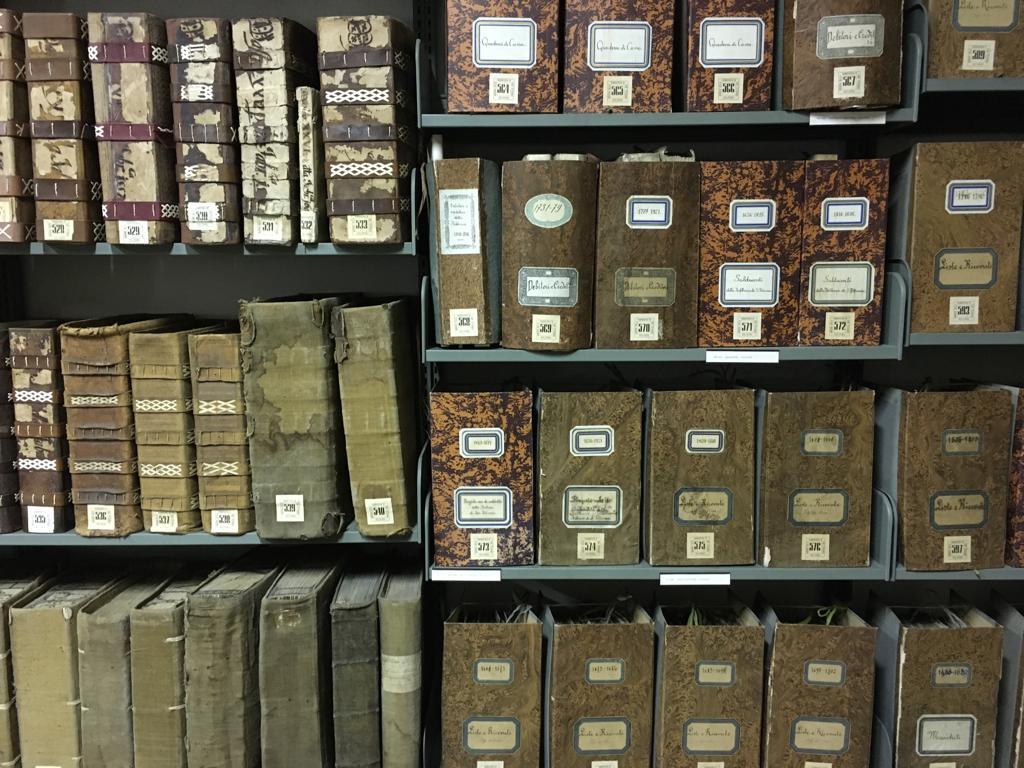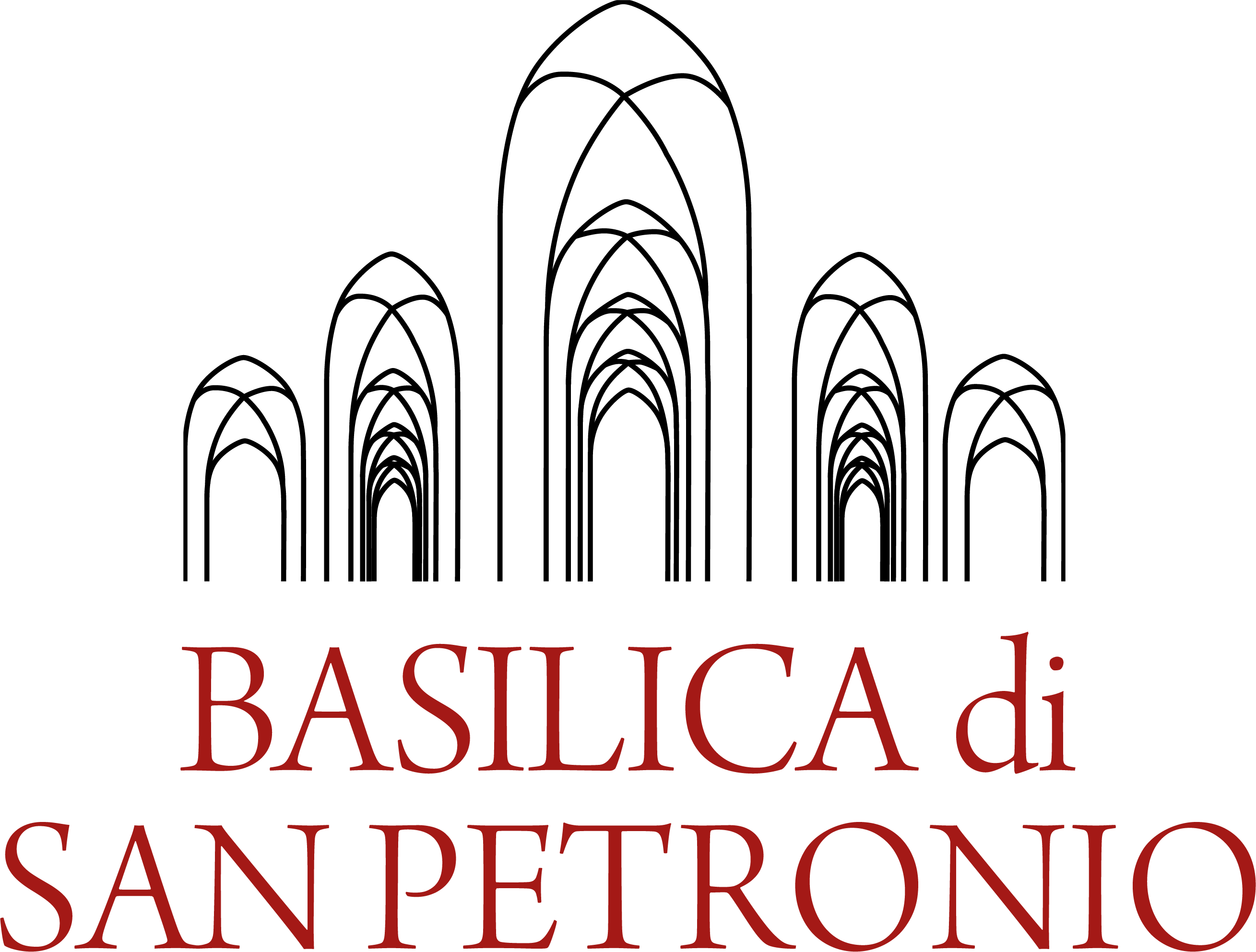Historical Archive of the Fabbriceria of San Petronio
It is possible to request material from the historical archive. To proceed, download and fill in the request form and send it to archivio.storico@basilicadisanpetronio.org

The Fabbrica or Fabbriceria of San Petronio is the institution created in 1389 by the Municipality of Bologna to oversee the construction and later the preservation of the great Basilica dedicated to the city’s patron saint and to manage the allocated funds.
The first record of a commission of four people – the superintendents – appointed to build the church dates back to 31 January 1390. The superintendents were entrusted with the tasks of assessing the buildings and land that had to be expropriated and carrying out the construction of the Basilica. In 1395, a commission completed the drafting of a Statute, which formed the legal basis for the Fabbriceria’s governance until the end of the 18th century.
The administration of the institution was entrusted to four churchwardens with a two-year term of office. There were various revenue sources: retention of four denaris per lira on payments by the municipality and a tithe on pious bequests, which was also extended to donations, allocation of fines for violations of the Statute, revenue for granting private individuals or corporations the right of patronage over the chapels in the new church, and donation of the inheritances of those who died without making a will.
When the church of San Petronio was erected as a collegiate church in 1463, the Sixteen Reformers of the State of Liberty decreed that the proceeds of the “duty of the Piazza and fruits” be used to pay the salaries of the instituted canons, chaplains and clerics and to purchase furnishings. All of these revenue sources were then supplemented by offerings from the faithful and the income from a property stock consisting mainly of the buildings purchased for demolition to enlarge the Basilica, which were rented out in the meantime for use as craft workshops, shops and colleges.
Starting in 1471, a permanent camerlengo with presidential powers was added to the four churchwardens. This office became a papal appointment, but was always conferred on prominent members of the Bolognese ruling class. In 1591, the number of churchwardens rose to five and in 1771 to seven. During the Napoleonic period, the Fabbriceria ended up being administered by the Municipality of Bologna, and after the Restoration, in 1826, the Cardinal Legate Giuseppe Albani definitively set the number of churchwardens at five.
From 1830, by order of the Cardinal Legate Tommaso Bernetti, the Fabbriceria was presided over by the pro tempore head of the municipal administration and this system continued even after the Unification of Italy, until the application of the concordat regulations in 1937. From then on, the churchwardens were appointed by prefectorial decree at the proposal of the Archbishop of Bologna.
This ‘concordat’ vestry was suppressed by decree of the President of the Republic in 1988. As a consequence of this, Cardinal Giacomo Biffi, Archbishop of Bologna, with an act of 21 March 1989, established a Council for Economic Affairs with the task of assisting the Primicerius of the Chapter of San Petronio, who is the legal representative of the Basilica, in the administration of the Basilica and its patrimony. Translated with DeepL.com (free version)
The Fabbriceria is currently composed of the pro tempore Primicerius of the Chapter, as President, and four churchwardens, two appointed by the Chapter and two by the Archbishop, with five-year appointments.
From the outset, the Fabbriceria was concerned with preserving its accounting records and the documents produced by the churchwardens in the course of their work.
In 1650, the churchwardens appointed one of their own, Senator Giovanni Lupari, to oversee the documents concerning the Fabbriceria, but until the next century, archiving remained an open question.
In 1773, work began to collect all documents kept in other locations on the second floor of the Fabbriceria’s residence, the current location. Domenico Marchioni, aide to the Chancellery of the Senate, was entrusted with the task of compiling a summary of the documents, with the help of notary Antonio Maria Tarsizio Giusti and Vincenzo Lazzari, amanuensis of the Bolognese Public Archive.
However, the work on the Fabbriceria Archive remained unfinished. The task was then entrusted in 1821 to court archivist Pietro Busatti, and in 1849 to Filippo Alfonso Fontana, archivist of the legation, who completed the work in 1851.
In the meantime, the archive was the subject of historical research. The work conducted by Giusti and Lazzari had already uncovered various important facts about the Basilica’s history: one of them was the identification of Antonio di Vincenzo as the first architect.
The growing interest in research led the Fabbriceria to consider providing the archive with an inventory. In 1891, the Fabbriceria turned to Carlo Malagola, director of the State Archives in Bologna, and then to Francesco Giorgi, an official of the State Archives in Bologna, who completed the task in 1899, although the results were far from the compilation of an inventory based on the historical method.
In 1930, Giorgi was again entrusted with the task of cataloguing the archive and finally drew up an inventory that was later printed (L’archivio della Fabbriceria di S. Petronio di Bologna riordinato da Francesco Giorgi, Bologna, stab. Luigi Parma, 1931).
Between 1959 and 1961, the premises of the Archives were renovated and the historical documentation was reorganised with updated criteria. The work ended with the inventory published in 2008.
The Fabbriceria Historical Archive currently consists of 726 items (including volumes, envelopes and bundles) and includes administrative and accounting records relating to the Basilica from the end of the 14th century to 1937. This is supplemented by an iconographic document collection of various nature and periods with drawings, prints and various iconography related to the Basilica (19th-20th centuries), to the Fabbriceria’s property (17th-20th centuries) and property not related to the Fabbriceria (17th-20th centuries).
(from Mario Fanti, L’archivio storico della Fabbriceria di San Petronio e il suo ordinamento, in Una Basilica per una città. Sei secoli in San Petronio. Atti del Convegno di studi per il sesto centenario di fondazione della Basilica di San Petronio, 1390-1990, edited by Mario Fanti and Deanna Lenzi, Bologna, Tipoarte, 1994, pp. 187-194)
The Fabbriceria Archive currently contains:
• The Fabbriceria’s own historical archive (1286-1951, 726 items)
• Aggregated archives:
– Master of ceremonies and sacristans of S. Petronio (16th-20th centuries, 58 items)
– Confraternities and pious associations in S. Petronio (17th-20th centuries, 15 items)
– Abolished Chapter of S. Petronio (16th-19th centuries, 50 items)
– Personal papers of Msgr. Gaetano Golfieri (19th century, 25 items)
– Manuscript and printed liturgical books (15th-20th centuries, 212 items)
– Executive committee for the work on the façade of the Basilica of San Petronio (19th-20th centuries, 16 items)
• Storage archive of the Fabbriceria (from 1937)
• Azienda di Chiesa Archive (since 1930)
• Papers of Msgr. Amleto Faenza (1925-2019, envelopes 2)
The Fabbriceria’s Historical Archive and the aggregated archives are accompanied by an analytical inventory (see L’Archivio della Fabbriceria di San Petronio in Bologna. Inventario, edited by Mario Fanti, Bologna, Costa, 2008). The papers of Msgr. Amleto Faenza are accompanied by a typewritten analytical list (2022). .
Staff
The archive has a director, Mario Fanti, who is supported by an assistant.
Location
The Fabbriceria Historical Archive is located inside the Basilica, on the south-eastern side. Material can be consulted in the archive’s designated room.
Access to the Archive
The Archive is open to the public by appointment by writing to: archivio.storico@basilicadisanpetronio.org. Or by contacting Patrizia Busi on +39 348 4414917.
Periods of closure are announced in advance on the Basilica’s information channels. Generally, the opening hours follow the opening and closing times of the Basilica.
Users with disabilities or other impairments can consult the required material in barrier-free rooms. To facilitate access, we recommend contacting the Archive staff in advance.
Users must comply with the rules below.
Download the Rules of Access to the Historical Archive
Reproductions for study purposes
• You can use your own equipment to make reproductions of consulted material for study purposes.
• When making reproductions using their own equipment, users are required to follow the instructions given by the archivist and to handle the documents with special care. The following is not permitted:
– use of flash or other portable light sources, scanners and tripods;
– climbing chairs or ladders, placing material on the ground;
– smoothing out papers with your hands, forcing books open, holding up books or documents;
– Special requirements due to the quantity of photographs or difficulties taking them must be reported in advance to the Archive staff, who will assess how to proceed on a case-by-case basis.
– Researchers are required to submit copies of publications that include images of materials for which they have obtained the appropriate authorisation for publication.
Reproductions for publication purposes
For the publication of reproductions of material from the Archive in printed volumes, posters, panels, e-books or websites, a request must be made to the Primicerius by downloading the form at the top of the page and sending it completed to the e-mail address archivio.storico@basilicadisanpetronio.org.
A fee is charged for these reproductions. The exact amount will be communicated by the Management on a case-by-case basis, depending on the characteristics, circulation and purpose of the reproduction.
Remote services
• Written information is provided remotely, to be requested at: archivio.storico@basilicadisanpetronio.org
• The provided information is intended to assist researchers in identifying useful sources and bibliography among the material in the Historical Archive. No document transcriptions are provided and the individual engaged in study and research activities cannot be substituted.
• You will receive a reply within 10-15 working days.
• You may obtain reproductions for study purposes following a specific request by writing to archivio.storico@basilicadisanpetronio.org, which will be followed by an interim reply and sending of the images within two working weeks, barring any problems or special requirements.
Reference bibliography
Mario Fanti, La Fabbrica di S. Petronio in Bologna dal XIV al XX secolo. Storia di una istituzione , Rome, Herder, 1980
Sesto centenario di fondazione della Basilica di San Petronio 1390-1990. Documenti per una storia , edited by Rosalba D’Amico… et al.; coordinated by Mario Fanti, Carlo De Angelis; introduction by Gina Fasoli, Bologna, Nuova Alfa, 1990, pp. 46-49
Una Basilica per una città. Sei secoli in San Petronio. Atti del Convegno di studi per il sesto centenario di fondazione della Basilica di San Petronio , 1390-1990, edited by Mario Fanti and Deanna Lenzi, Bologna, Tipoarte, 1994
L’Archivio della Fabbriceria di San Petronio in Bologna. Inventario edited by Mario Fanti, Bologna, Costa, 2008
Il museo di San Petronio in Bologna, texts by Antonio Buitoni, Mario Fanti, Massimo Medica; edited by Mario Fanti; foreword by Jadranka Bentini, Bologna, Costa, 2003
M. Fanti, M. Fanti, La raccolta iconografica dell’Archivio della Fabbriceria di San Petronio in Bologna in Arti a confronto. Studi in onore di Anna Maria Matteucci , edited by Deanna Lenzi, Bologna, Editrice Compositori, 2004, pp. 41-47.
